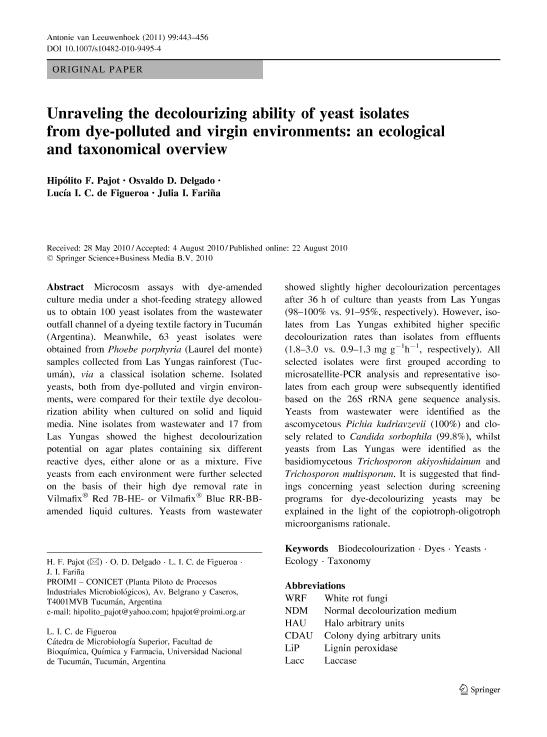Mostrar el registro sencillo del ítem
dc.contributor.author
Pajot, Hipólito Fernando

dc.contributor.author
Delgado, Osvaldo Daniel

dc.contributor.author
Castellanos de Figueroa, Lucia Ines

dc.contributor.author
Fariña, Julia Inés

dc.date.available
2017-05-31T17:57:01Z
dc.date.issued
2011-01
dc.identifier.citation
Pajot, Hipólito Fernando; Delgado, Osvaldo Daniel; Castellanos de Figueroa, Lucia Ines; Fariña, Julia Inés; Unraveling the decolourizing ability of yeast isolates from dye-polluted and virgin environments: an ecological and taxonomical overview; Springer; Anton Leeuw Int. J. G.; 99; 3; 1-2011; 443-456
dc.identifier.issn
0003-6072
dc.identifier.uri
http://hdl.handle.net/11336/17164
dc.description.abstract
Microcosm assays with dye-amended culture media under a shot-feeding strategy allowed us to obtain 100 yeast isolates from the wastewater outfall channel of a dyeing textile factory in Tucuman (Argentina). Meanwhile, 63 yeast isolates were obtained from Phoebe porphyria (Laurel del monte) samples collected from Las Yungas rainforest (Tucuman), via a classical isolation scheme. Isolated yeasts, both from dye-polluted and virgin environments, were compared for their textile dye decolourization ability when cultured on solid and liquid media. Nine isolates from wastewater and 17 from Las Yungas showed the highest decolourization potential on agar plates containing six different reactive dyes, either alone or as a mixture. Five yeasts from each environment were further selected on the basis of their high dye removal rate in Vilmafix Red 7B-HE- or Vilmafix Blue RR-BBamended liquid cultures. Yeasts from wastewater showed slightly higher decolourization percentages after 36 h of culture than yeasts from Las Yungas (98?100% vs. 91?95%, respectively). However, isolates from Las Yungas exhibited higher specific decolourization rates than isolates from effluents (1.8?3.0 vs. 0.9?1.3 mg g-1 h-1 , respectively). All selected isolates were first grouped according to microsatellite-PCR analysis and representative isolates from each group were subsequently identified based on the 26S rRNA gene sequence analysis. Yeasts from wastewater were identified as the ascomycetous Pichia kudriavzevii (100%) and closely related to Candida sorbophila (99.8%), whilst yeasts from Las Yungas were identified as the basidiomycetous Trichosporon akiyoshidainum and Trichosporon multisporum. It is suggested that findings concerning yeast selection during screening programs for dye-decolourizing yeasts may be explained in the light of the copiotroph-oligotroph microorganisms rationale.
dc.format
application/pdf
dc.language.iso
eng
dc.publisher
Springer

dc.rights
info:eu-repo/semantics/openAccess
dc.rights.uri
https://creativecommons.org/licenses/by-nc-sa/2.5/ar/
dc.subject
Yeast Isolates
dc.subject
Biodecolourization
dc.subject
Dye-Polluted
dc.subject
Ecology
dc.subject
Taxonomy
dc.subject.classification
Otras Biotecnología del Medio Ambiente

dc.subject.classification
Biotecnología del Medio Ambiente

dc.subject.classification
INGENIERÍAS Y TECNOLOGÍAS

dc.title
Unraveling the decolourizing ability of yeast isolates from dye-polluted and virgin environments: an ecological and taxonomical overview
dc.type
info:eu-repo/semantics/article
dc.type
info:ar-repo/semantics/artículo
dc.type
info:eu-repo/semantics/publishedVersion
dc.date.updated
2016-02-05T14:59:18Z
dc.journal.volume
99
dc.journal.number
3
dc.journal.pagination
443-456
dc.journal.pais
Alemania

dc.journal.ciudad
Berlín
dc.description.fil
Fil: Pajot, Hipólito Fernando. Consejo Nacional de Investigaciones Científicas y Técnicas. Centro Científico Tecnológico Tucumán. Planta Piloto de Procesos Industriales Microbiológicos (i); Argentina
dc.description.fil
Fil: Delgado, Osvaldo Daniel. Consejo Nacional de Investigaciones Científicas y Técnicas. Centro Científico Tecnológico Tucumán. Planta Piloto de Procesos Industriales Microbiológicos (i); Argentina
dc.description.fil
Fil: Castellanos de Figueroa, Lucia Ines. Consejo Nacional de Investigaciones Científicas y Técnicas. Centro Científico Tecnológico Tucumán. Planta Piloto de Procesos Industriales Microbiológicos (i); Argentina
dc.description.fil
Fil: Fariña, Julia Inés. Consejo Nacional de Investigaciones Científicas y Técnicas. Centro Científico Tecnológico Tucumán. Planta Piloto de Procesos Industriales Microbiológicos (i); Argentina
dc.journal.title
Anton Leeuw Int. J. G.

dc.relation.alternativeid
info:eu-repo/semantics/altIdentifier/doi/http://dx.doi.org/10.1007/s10482-010-9495-4
dc.relation.alternativeid
info:eu-repo/semantics/altIdentifier/url/https://link.springer.com/article/10.1007%2Fs10482-010-9495-4
Archivos asociados
